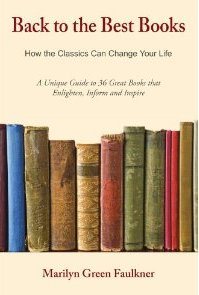The following is an excerpt from Back to the Best Books: How the Classics Can Change Your Life, available at Amazon.com. Back to the Best Books was recently selected as a finalist for the 2011 Indie Book Awards! It’s a great gift for the book lovers in your life. If your book group is ready for some great book recommendations pick up Back to the Best Books for a review of 36 classics, with author bios and discussion questions. And for a new book recommendation every week, go to Marilyn’s website at www.backtothebestbooks.com.
Summer is coming and I’m in the mood for a good, cozy murder mystery, aren’t you? So let’s nudge Tolstoy and Austen aside for a moment and talk about that underrated genre that actually accounts for over one-third of all fiction sold in the English-speaking world: the mystery novel.
Mysteries, Myth and Meaning
Why do we like to read mysteries? The obvious answers are these: we read such stories for entertainment, escape, and in order to solve a puzzle. However, these reasons fail to account for the universal appeal of mystery stories, since a good crossword would satisfy all those requirements. The love of a good mystery crosses all lines of class, race, economic status and lifestyle. Everybody likes them and new mysteries constantly appear to great acclaim. Marie Rodell, in her book Mystery Fiction, (1943) digs a little deeper into why everybody likes to find a body in the library. People, she said, read mysteries for four basic reasons:
1. The vicarious thrill of the manhunt… carried on intellectually in the cleverness of detective and reader.
2. The satisfaction of seeing the transgressor punished.
3. A sense of identification with the people [the hero principally] and events in the story which will make the reader feel more heroic.
4. A sense of conviction about the reality of the story.
I’m not sure if I buy the fourth reason, (there is nothing very believable about Sherlock Holmes, but we love him) but I do think Ms. Rodell is on to something when she talks about identification with the hero. This leads us into a realm far deeper than mere literary device, and suggests that the modern mystery is an outgrowth of the ancient myth.
Mythical themes, or “functions,” are as old as the human ability to tell stories, and the mystery novel ties into one of the oldest: the journey of the hero. In every good mystery the mythical elements are in place. Death (the body in the library) comes as a result of evil (the murderer) and is overcome by reason (the clever work of the detective) and bravery (often facing the criminal alone). Our hero ventures into the world of the crime, is challenged and threatened, then overcomes through reason and courage, and the reader is left with an assurance that the unknown dangers that terrify us (the greatest of which is death) may be faced successfully. So the mystery is more than an escape; it is a way of preparing the mind and spirit to face the next real-life challenge by placing ourselves in the archetypical place of the hero. And you thought you were just killing a couple of hours by the pool!
Mysteries come in all shapes and sizes, but my two favorites are the detective and the “cozy” mystery. A cozy mystery is one that takes place in an enclosed or secluded place (a country house, quaint village, or monastery for example) that we would not normally associate with murder and mayhem. The hero that solves the crime is usually an unlikely character such as an old woman (Agatha Christie’s Miss Marple), a priest (Ellis Peters’ Brother Cadfael) or even an archaeologist (Elizabeth Peters’ Amelia Peabody). Let’s look at two of the greats.
Two Great Ladies of Mystery: Agatha Christie and Dorothy Sayers
Everybody knows Agatha Christie. From her first novel The Mysterious Affair at Styles (1920) to her last, Sleeping Murder (1976), she enjoyed a career that spanned over fifty years, and revenues from her books reach into the billions of dollars. Only the Bible has sold more copies than her collected works. They have been translated to dozens of languages, inspired numerous other authors’ works, and have been adapted to radio, the stage, and film. Her two greatest characters, the fussy, debonair Hercule Poirot and the deceptively frumpy Miss Marple, are beloved by millions of readers.
Christie almost single-handedly created the genre of the “cozy” mystery, with Miss Jane Marple (whom she modeled after her grandmother) as the perfect sleuth: elderly, unassuming, and devastatingly brilliant. Her wry take on the world around her continually delights us, as she avers, “The young people think the old people are fools, but the old people know the young people are fools.”
Like Sherlock Holmes, Jane Marple has a certain style that is at once old-fashioned and very modern. She appears to be very conservative but is in fact one step ahead of most of the young people around her. Here is a rave about Miss Marple from an unlikely source: a website called “Feminist Review:”
“I celebrate Miss Marple! All feminists should know this character. Miss Marple’s stories constantly stir up the hornet’s nest of sexism and ageism; this elderly sleuth is treated as “second class” because she’s a woman, she’s old, and therefore, is seen as unable to contribute anything of worth. When she solves the case, and she always does, the people around her are in shock. The old woman has brains, how strange!” (Feminist Review, website)
The Little Grey Cells
Though Christie’s other hero, Hercule Poirot, is a detective, his adventures seem to fit more into the “cozy” category of mystery, since he almost never gets his manicured hands dirty, and the resolution generally occurs in a drawing room, with all the suspects obediently present for the grand revelation. Hercule Poirot has so many annoying character traits that even Christie grew weary of him. She complained now and then that the character would not leave her alone! (In her diary she called him “insufferable.”) But the public loved him and adaptations of the Poirot stories continue to run on public television. The mysteries involving both Poirot and Miss Marple are more about figuring things out than running down the criminal. (The dirty, grimier aspects of justice are left to less brilliant, more active creatures.) As Poirot says in the very first book:
“This affair must all be unravelled from within.” He tapped his forehead. “These little grey cells. It is ‘up to them’—as you say over here.“ (Poirot, ch. 10)
One of the most inspiring aspects of Christie’s life is, of course, her longevity. She went on producing excellent mysteries long after most people would have retired, and stayed involved in productions of her work right up until the end of her life. She was married twice and spent many years on archaeological digs with her second husband. She spoke about a time of life that is difficult for many women, but for her was a much-needed “second wind.”
“I have enjoyed greatly the second blooming that comes when you finish the life of the emotions and of personal relations; and suddenly you find—at the age of fifty, say—that a whole new life has opened before you, filled with things you can think about, study, or read about.
… It is as if a fresh sap of ideas and thoughts was rising in you.”—An Autobiography (1977).
If you haven’t read Agatha Christie in awhile, I suggest listening to a few of the stories through Recorded Books on Tape, or Audible.com. Christie’s prose is so engaging and her dialogue is so believable that recorded versions are a delight. I recently reread Murder on the Orient Express and found (though I remember the ending and there was no surprise in store) that the quick, sure creation of character and the delightful interplay between Poirot and his subordinates is continually fresh. Agatha Christie’s genius continues to shine even after many readings, and that is the mark of a classic.
In order to be sure that the final fate of her characters was in her control, Christie wrote a final story for each, titled Curtain and Sleeping Murder respectively, and put them in a bank vault during the 1930’s. During the last two years of her life, as her health failed, she published the stories, ending the life of Poirot, and retiring Miss Marple to her home in Sr. Mary Meade. Hercule Poirot has the distinction of being the only fictional character ever to receive an obituary in the New York Times.
A Whimsical Detective and a Brilliant Author
Though I adore Hercule Poirot and want to be related to Jane Marple, I have another brilliant, monocled detective that I like even better, Lord Peter Wimsey. He first appears in a delightful little novel titled, Whose Body? first published in 1923. We are introduced to Lord Peter, book collector, confirmed bachelor and amateur sleuth, when his mother’s neighbor finds a body in his bathtub, “with nothing on but a pair of pince-nez.” Peter’s mother asks him to solve the “problem,” and the fun begins.
Over the next several years, Dorothy Sayers, scholar, poet and teacher, published a series of mysteries featuring Lord Peter, his incomparable butler Bunter (like Jeeves with detective skills) and the love of his life, Harriet Vane. Harriet is obviously Sayers’s alter ego; a scholar/mystery novelist with grave misgivings about marrying the “Lord of the Manor.” In Strong Poison, she is introduced to us as an accused murderess, on trial for the poisoning death of her lover. It is years, and a few more novels, before these two tie the knot, but well worth the journey. Harriet is a very modern character, torn between her desire for independence and a life of the mind and her love for her rescuer and most ardent admirer, the dapper Lord Peter. Because this is a series we are able to trace her development in a deeper way. Maureen Corrigan, book reviewer for PBS (and a fellow Sayers fan) explains:
“One of the great, largely unacknowledged advantages of series fiction is that a story line can be strung out over several novels, allowing a character to think, falter and reverse direction, as Harriet does.” (Leave Me Alone, I’m Reading, P. 110)
Dorothy Sayers brings a meticulous eye for detail to her plots, and her dry sense of humor combined with her vast knowledge of English manners, customs and class distinctions, create a world that is always a joy to visit. In between “Lord Peter” mysteries, Sayers wrote another excellent novel titled Nine Tailors (nothing to do with sewing) and introduces us to another part of English life that is strange to us: the ancient art of “change-ringing,” in the old churches with their great bell-ringing tradition. (The “Nine Tailors” are nine bells.)
Dorothy Sayers was quite a character in her own right. She worked for several years writing advertising copy until she was able to support herself by the sale of her books and stories. During these years she joined a motorcycle gang, fell in love with a member, and bore him a son, Anthony. Through her study of medieval literature she became friends with C.S. Lewis and J.R.R. Tolkein. She converted to Christianity.
Other Great Reads: The Old Bailey to Zebra Drive
If you like the drama of the detective story but want to skip serial killers and the more shocking brutality common today, try some of the novels from the “golden age” of mysteries, such as Margery Allingham’s Robert Campion series. In the “cozy” category you must read G.K. Chesterton’s Father Brown series and Ellis Peters’ Brother Cadfael stories. And if you haven’t yet met Rumpole of the Bailey and his beloved wife Hilda (“she who must be obeyed”) you are in for a hilarious treat from John Mortimer. A mystery novel that stands on its own, in the same class as The Moonstone, is The Name of the Rose, by Umberto Eco. Eco is so brilliant that this is the only novel of his that I understand, and I love it for that reason alone! Finally, Dorothy Sayers’s modern counterpart is, in my opinion, P.D. James, another woman writer of detective fiction. Her protagonist, Adam Dalgliesh, is a Scottish poet who doubles as a police commander. All of her novels are literate, thoughtful and beautifully constructed.
The Mystery Writers of America recently compiled a list of the hundred best mystery novels, and out of those I would recommend twenty that I particularly love. Cozy and detective mysteries both figure in this list, and most of these are part of a series by a truly talented author so you have lots of reading in store.
For my list of twenty great mysteries, go to my website at www.backtothebestbooks.com


















